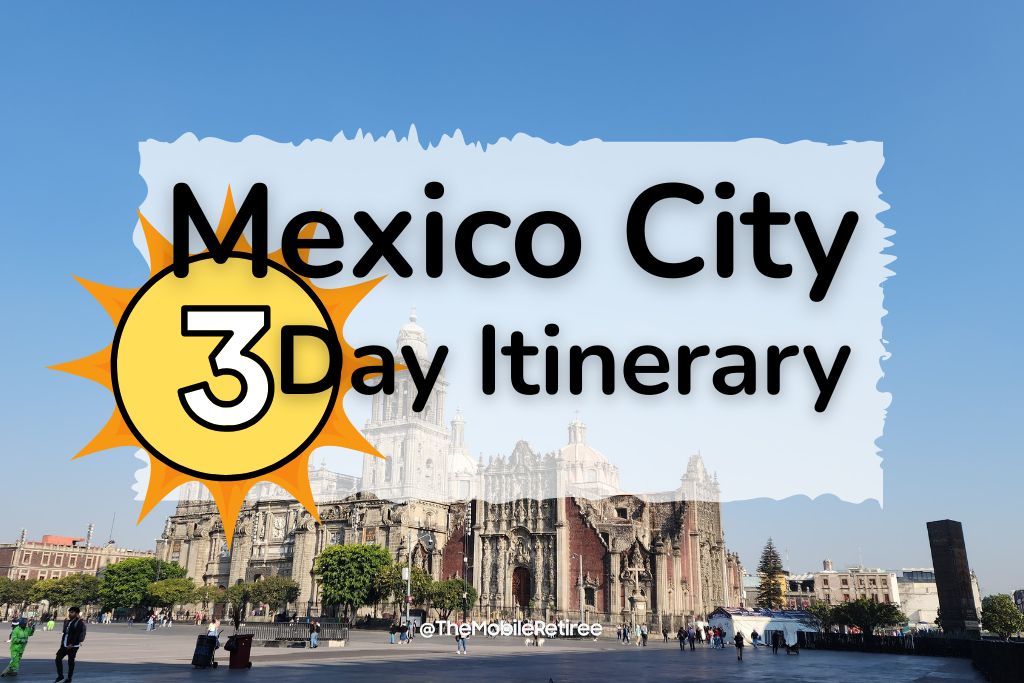3 Days in Mexico City: A Budget-Friendly Itinerary
Three days in Mexico City is just enough to fall in love with its vibrant energy, world-class cuisine, and rich history. Whether you’re squeezing in a long weekend, planning a stopover, or simply want to experience the city’s highlights on a tight schedule, this 3-day itinerary is designed for curious, budget-conscious travelers who crave authentic local flavor. Expect walkable adventures, stunning architecture, and unforgettable eats—all curated from our real nomad experiences and local insights.

Where to stay in Mexico City?
This is the place we stayed in Mexico City. It’s step from Zócalo, clean, comfortable, and the restaurant and breakfast buffet offered good food and value!
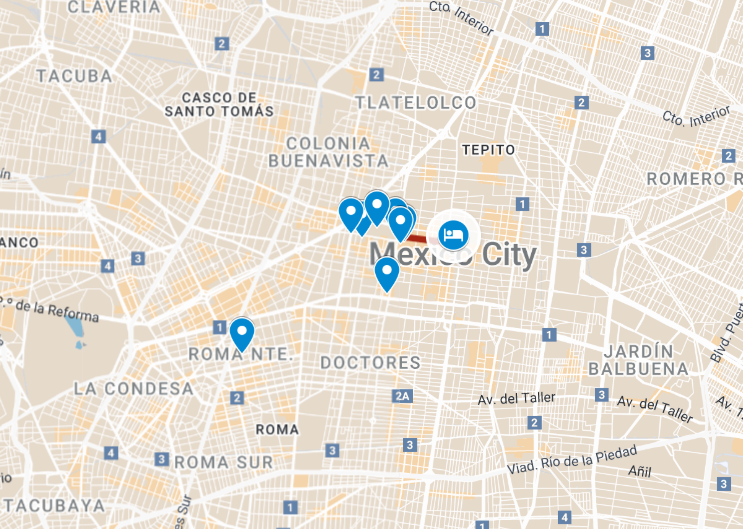
Day 1: Art, Museums & Parks
Morning:
- Stroll Av. Francisco I. Madero: Begin your adventure with a stroll down this lively pedestrian street, browse artisan shops, and take in the historic ambiance.
- Casa de Azulejos: Stop for coffee and photos in this iconic tiled building.
- Palacio de Bellas Artes: Marvel at the ornate lobby (free) and, if interested, visit the Museum of Architecture upstairs (small fee).
Where to Eat:
- El Cardenal Alameda: Traditional Mexican food at its finest.
- Street Food: Mexico city is full of street food options
- Mercado de San Juan: Sample local flavors – tamales, tacos al pastor, and fresh juice – at this bustling market, a favorite for both locals and chefs. (a short ride needed)
Afternoon:
- Stroll Alameda Central Park: Relax in this green oasis, enjoy people-watching, and take in the sculptures and fountains.
- Museo Frida Kahlo (advance tickets recommended): If you’re interested in art and Mexican culture, the Blue House in Coyoacán is a highlight (requires a short ride).
Evening:
- Sunset at Torre Latinoamericana:
Head up to the observation deck for sweeping city views as the sun sets (entry fee applies). - Dinner in Condesa or Roma Norte: Choose a trendy spot for dinner – these neighborhoods are known for their vibrant food scenes and relaxed, leafy streets.
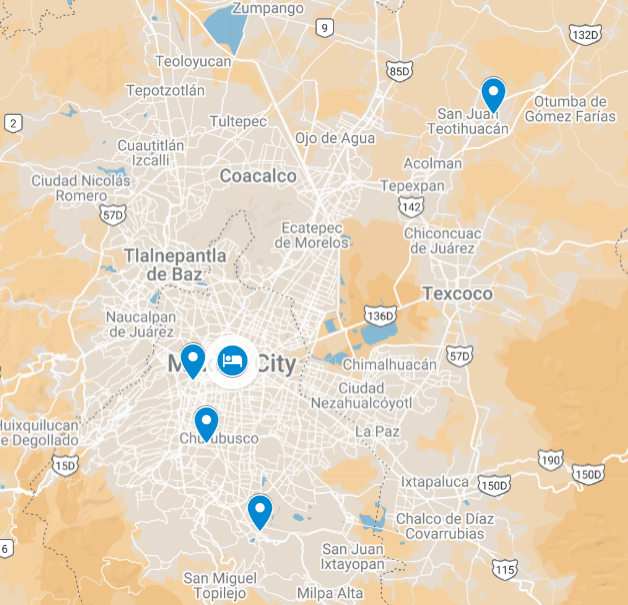
Day 2: Pyramids or Neighborhood Exploration
Option A: Teotihuacán Day Trip
- Morning & Afternoon: Take a bus, guided tour, or private car to the Pyramids of the Sun & Moon at Teotihuacán. Explore the Avenue of the Dead, and consider booking a Hot Air Balloon Flight over the Pyramids for a unique perspective (entry fee; tour/balloon extra).
- Evening: Return to the city, enjoy a light dinner, and rest.
Option B: Local Gems & Markets
- Morning: Explore Coyoacán – wander the cobblestone streets, visit the local market, and soak up the bohemian vibe.
- Afternoon: Discover Roma Norte or Condesa: browse bookstores, sip coffee in a quiet plaza, and enjoy street art and boutique shops.
- Evening: Wrap up your trip with a farewell rooftop dinner (try Arango Cantina, King Cole Bar or Supra Roma Rooftop) or a boat ride in Xochimilco if time allows.
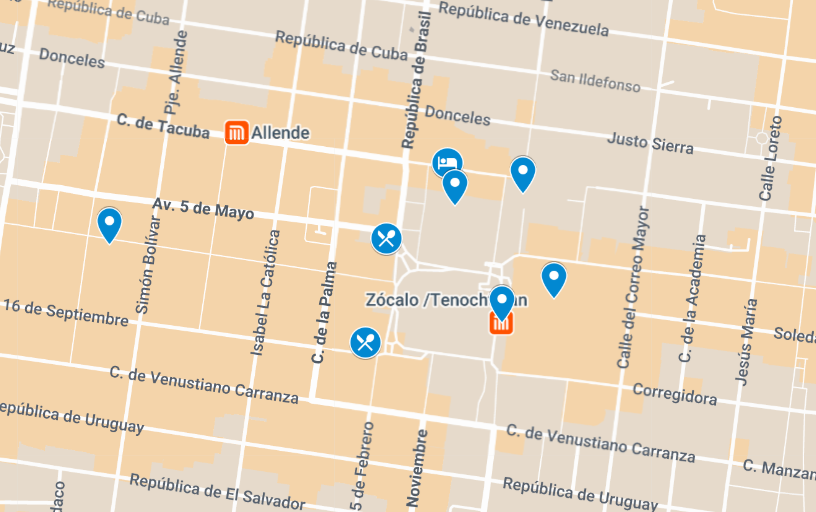
Day 3: Historic Core & Rooftop Views
Morning:
- Zócalo (Constitution Square): Begin your adventure in the heart of Mexico City. Absorb the energy of the city’s main plaza, watch the daily flag ceremony in the evening, and admire the grandeur of the surrounding architecture.
- Metropolitan Cathedral & Tabernacle: Step inside this architectural marvel—free to enter, and a must-see for its blend of baroque and neoclassical styles and its fascinating history.
Lunch:
- Rooftop Lunch: Enjoy panoramic views and delicious food at either Balcón del Zócalo or Gran Hotel Ciudad – both offer stunning perspectives over the plaza and are great for people-watching.
Afternoon:
- Templo Mayor Ruins: Explore the remnants of the ancient Aztec city beneath modern Mexico City. The outdoor ruins are atmospheric, and the museum provides excellent context (small entry fee).
- Palacio Nacional (Fridays only): If you’re visiting on a Friday, don’t miss Diego Rivera’s murals inside the National Palace (ID required for entry).
Evening:
- Stroll Av. Francisco I. Madero: Walk this lively pedestrian street, browse artisan shops, and take in the historic ambiance.
- Palacio de Iturbide: Peek inside this beautiful palace (free entry) and enjoy any current art exhibits.
Budget Tips
- Accommodation: Stay in Centro Histórico for walkability and proximity to major sites.
- Food: Mix street food and casual restaurants for meals ($15–$25 USD/day).
- Transport: Walk as much as possible; use Metro, Uber, or inexpensive taxis for longer distances.
- Attractions: Many museums and sites are free or low-cost; splurge on one or two must-sees if your budget allows.
Other Posts from our visit to Mexico City
- Mexico City Travel Guide
- Mexico City 5-Day Itinerary: Culture, Cuisine & Local Charm on a Budget
- Exploring Teotihuacán: Our Day Trip to the Pyramids from Mexico City
- Exploring Palacio de Bellas Artes – Mexico City, Mexico
- Budget-Friendly Adventures in Mexico City: 9 Free or Nearly Free Museums, Parks and Public Spaces
- From Chile to Guanajuato: Why Mexico City Was the Perfect Stop for Nomads Like Us
Best Time to Visit
Mexico City is a good year-round destination. Other than late April / early May, it never gets really hot and things always cool down later. Weather is never too cold – a sweater will suffice even on the worst morning in January as it will warm later. There is always something going on.
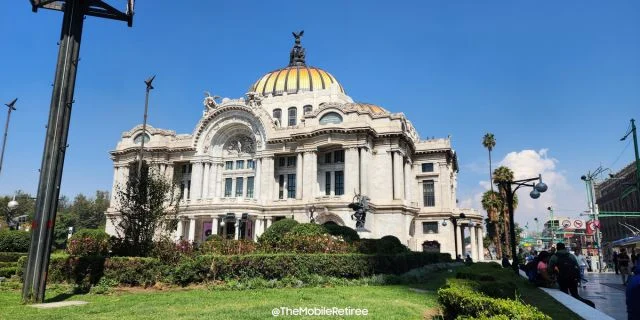
Getting Around Mexico City
Metro (Subway)
Mexico City’s comprehensive metro system has 195 stations spread across 14 lines; its a cost-effective and convenient way to avoid traffic above ground. For more information on routes, see here.
Metrobús
You can use the same prepaid Metro Card used for the Metro to board any Metrobús line. Metrobús is simple, and it’s very often the fastest way to get from one point to another. There are three main types of buses in Mexico City: Pesero, Metrobus, and Trolebus. Buses run from early morning until late night, after which you’ll need to take a taxi. A complete map of the Metrobus system is available here.
Bike
Though Mexico City doesn’t have a dedicated cycle route, bikes are available to hire for free from a kiosk on the west side of Catedral Metropolitana.
Taxis and rideshare
Taxis in Mexico City are generally inexpensive and easy to flag down on the street—ensure that you only use registered cabs that display a sticker in the front window. Rideshare apps such as Uber are available.
Frequently Asked Questions about visiting Mexico City
What are 5 interesting facts about Mexico City?
1. Built on a Lake – Mexico City is built on the ruins of Tenochtitlán, the capital of the Aztec Empire, which was originally located on an island in Lake Texcoco. Because of this, parts of the city are still slowly sinking—some areas by several inches per year.
2. One of the Oldest Continually Inhabited Cities in the Americas – The area has been settled for thousands of years. Tenochtitlán was founded in 1325, and after the Spanish conquest in 1521, it became Mexico City, making it one of the oldest continuously inhabited urban areas in the Western Hemisphere.
3. It Has More Museums Than Almost Any City in the World – With over 150 museums, Mexico City rivals London and Paris in cultural offerings. Highlights include the National Museum of Anthropology, Frida Kahlo Museum, and the Templo Mayor Museum showcasing Aztec ruins.
4. Home to the Largest University in Latin America – The National Autonomous University of Mexico (UNAM) is not only the largest but also one of the oldest universities in the Americas. Its main campus is a UNESCO World Heritage Site, celebrated for its murals and architecture.
5. High Altitude = Cooler Than You’d Expect – Despite being in the tropics, Mexico City sits at about 7,350 feet (2,240 meters) above sea level. This elevation gives it a mild climate year-round, with cooler temperatures than many visitors expect.
Can I brush my teeth with tap water in Mexico City?
Depends? How good is your gut health? Mexico City’s tap water is not recommended for drinking, and most locals prefer to use bottled or filtered water for this purpose. Our hotel had free chilled bottled water available in the lobby so we could always grab a bottle on our way out to sightsee.
Is Mexico City safe?
As with ANY tourist mecca – Be aware of your surroundings!
While many areas are safe, be cautious in secluded or less-familiar areas, especially at night. Keep an eye on your wallet and cell phone at all times, especially at very crowded, touristy places.What’s the weather like in Mexico City?
Winter (Dec, Jan, Feb): Avg High from 72°F to 76°F – Can get chilly in the evening – bring a sweater
Spring (March, April, May): Avg High around 78°F
Summer (June, July, August): Daily highs are from 74°F to 79°F
Fall (Sept, Oct, Nov): Daily high around 73°F
Weatherspark is a great resource for any traveler!What language is spoken in Mexico City
Spanish is the most widely spoken language of Mexico, but it is not legally the official language. The government recognizes 68 other languages spoken in the country. Most hotels and tourism related services offer at least some English.
How much to tip in Mexico City?
The custom is to leave tips of about 10%. This can rise to 15% if the service was exceptional.
What is the timezone?
Central Standard Time (GMT-6)
What are the voltage/plug types?
Mexico’s electricity is essentially the same as that in the United States. Both countries use the same voltage (110-120V) and frequency (60 Hz). There are two associated plug types: Type A (two flat parallel prongs) and Type B (two flat parallel prongs and a grounding prong). Most US-made appliances can be used in Mexico without the need for a converter or transformer.
What is the currency?
Mexican Peso. Its currency code is MXN and its symbol is $. To distinguish it from other currencies using the $ symbol, the peso is sometimes written as M$, MX$, or MEX$
Do I need a visa to visit Mexico
If you’re visiting Mexico City from overseas, see if you need a visa using this website. Your passport must be valid for at least six months after the date of entry.
What are the cheapest months to visit Mexico City?
June through October are the wettest months in Mexico, so if you’re willing to risk these less-than-ideal conditions (particularly in mid-September, the peak of the Mexican hurricane season) your flight and hotel costs should be correspondingly low.
How many days do you need in Mexico City?
To experience a good overview of Mexico City’s highlights, 5 days is generally recommended. Five days allows you time to explore the historic center, major museums, and key neighborhoods like Roma and Condesa. If you’re interested in more in-depth exploration or incorporating day trips, consider extending your stay to a week or even longer
Is Mexico City walkable?
Yes, Mexico City is quite walkable! Though the city is HUGE and sprawling – many areas, particularly in the city center and some residential neighborhoods, are designed with pedestrians in mind.
Will I get altitude sickness in Mexico City?
Mexico City sits at around 7,200 feet (2,200 meters) above sea level, which is high enough for some individuals to experience symptoms, although losst of people visit Mexico City with no symptoms at all. If you’re planning on visiting nearby mountains, you should be sure to spend several days in Mexico City Center before traveling any higher.

Support independent travel writers
Love our travel stories? Be part of our journey! Help us brew up more travel tales and support independent content creators like us, Buy Us A Coffee. We’ll give you a shout out in one of our videos! Click the cup to show your support!


